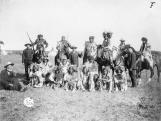14
Constable Fred Bagley recounts the location and discovery of the victims of Swift Runner.He wrote in his journal on June 7th and 8th, the details of the search party, where the bones were located, the condition of the camp and Swift Runners reaction once confronted with the evidence.
16
"Their search was ended almost at once when they found on an island in the middle of a large muskeg which was still partially frozen, and thus easier access to the island was afforded than if the party had arrived there a month later when the muskeg would be completely thawed out, and practically impassable.There they found his traps hanging on the limb of a tree; his moose hide tepee (which he claimed previously he had eaten) neatly folded and stowed away in the branches of a tree, and scattered around the dead campfire and tripod and ghastly evidence of his cannibalistic orgies in the presence of human skulls and bones, and greasy smears on the trunks of the surrounding trees where he had frequently wiped his greasy hands.
A couple of gunny sacks full of skulls and bones were brought in."
18
"At a preliminary examination held yesterday before Colonel Jarvis, Kah-kee-see-koo-chin was committed for trial by a higher court, on a charge of murder and cannibalism. He identified his wife's skull as it laid on the Colonel's table by sticking his finger in the eye socket of one of the many skulls there, and saying, with a merry laugh, 'That is my wife'."19
Religion and Prosperity20
The warriors of the Cree Nation performed a Sun Dance prior to their engagements with mounted forces during the Métis uprising.For the tribe, it was an annual religious ceremony celebrated in July. The importance of the dance has not diminished and has 'more than religious significance alone: it is equally meaningful as a reaffirmation of community identity, and it promotes a vital sense of solidarity among the participants'.
22
Sun Dance and Cree Warriors.White man second at left has military/police uniform; Native subjects are dressed as dancers in what appears to be authentic dress.
Info courtesy Professor M. Wilson, U. of Lethbridge, 1990
23
The Rebel Cause25
Chief Big Bear, leader for the Cree nation, was involved in the North West Rebellion of 1885 out of necessity.Desperation set in after watching his people suffer starvation with the depletion of the buffalo herds and the organization of the tribes onto reserves. Upon hearing of the Frog Lake Massacre, he organized an attack against the whites at Frenchman's Butte.
Sergeant-Major Sam Steele and his scouts defeated the Cree warriors and was the arresting officer of Chief Big Bear.
Carter Yellowbird, a descendant of Big Bear, narrates the story of Chief Big Bear as told by Edward Ahenakew, a Cree ordained Anglican priest born of the Sandy Lake Reserve, who documented the story of Chief Big Bear as told to him by Chief Thunderchild on the Little Pine Reserve before his death in 1927:
27
"Though he was stubborn in his demands for better terms, Big Bear did everything in his power to restrain the Crees in any encounters with government authority, as at Battleford in the summer of 1884.He did not want an Indian rising. He knew the power of the whites, and recognized that the Indians had all to lose and nothing to gain by fighting.
His efforts were directed to bringing about an Indian union that could force concessions by a potential threat rather than by actual hostilities. Small and scattered reserves weakened that power."


